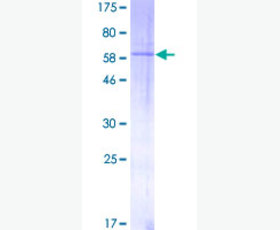Recombinant Human Neurexophilin-1/NXPH1
| Product name: | Recombinant Human Neurexophilin-1/NXPH1 |
| Source: | Human Cells |
| Purity: | Greater than 95% as determined by reducing SDS-PAGE. |
| Buffer Formulation: | Lyophilized from a 0.2 μm filtered solution of 20mM PB, 150mM NaCl, pH 7.2. |
| Applications: | Applications:SDS-PAGE; WB; ELISA; IP. |
| Storage: | Avoid repeated freeze/thaw cycles. Store at 2-8 oC for one month. Aliquot and store at -80 oC for 12 months. |
| UOM: | 100ug/50ug/200ug/1mg/1g |
| Source | Human Cells |
| Description | Recombinant Human Neurexophilin-1 is produced by our Mammalian expression system and the target gene encoding Ala22-Gly271 is expressed with a 6His tag at the C-terminus. |
| Names | Neurexophilin-1, NXPH1, NPH1 |
| Accession # | P58417 |
| Formulation | Lyophilized from a 0.2 μm filtered solution of 20mM PB, 150mM NaCl, pH 7.2. |
| Shipping |
The product is shipped at ambient temperature. |
| Reconstitution |
Always centrifuge tubes before opening. Do not mix by vortex or pipetting. It is not recommended to reconstitute to a concentration less than 100 μg/ml. Dissolve the lyophilized protein in ddH2O. Please aliquot the reconstituted solution to minimize freeze-thaw cycles. |
| Storage |
Lyophilized protein should be stored at < -20°C, though stable at room temperature for 3 weeks. Reconstituted protein solution can be stored at 4-7°C for 2-7 days. Aliquots of reconstituted samples are stable at < -20°C for 3 months. |
| Purity |
Greater than 95% as determined by reducing SDS-PAGE. |
| Endotoxin | Less than 0.1 ng/µg (1 IEU/µg) as determined by LAL test. |
| Amino Acid Sequence |
ANLTNGGKSELLKSGSSKSTLKHIWTESSKDLSISRLLSQTFRGKENDTDLDLRYDTPEPYSEQD LWDWLRNSTDLQEPRPRAKRRPIVKTGKFKKMFGWGDFHSNIKTVKLNLLITGKIVDHGNGTFSV YFRHNSTGQGNVSVSLVPPTKIVEFDLAQQTVIDAKDSKSFNCRIEYEKVDKATKNTLCNYDPSK TCYQEQTQSHVSWLCSKPFKVICIYISFYSTDYKLVQKVCPDYNYHSDTPYFPSGVDHHHHHH
|
| Background | Neurexophilin-1 (NXPH1) is a member of Neurexophilin family. NXPH1 consist of 271 amino acis. It contains a 21 amino acid signal peptide, 86 amino acid propeptide, and 164 amino acid mature protein. NXPH1 is expressed in subpopulations of neurons within the cerebral cortex, cerebellum and olfactory bulb that are thought to be inhibitory interneurons. In humans, NXPH2 and NXPH3 are most similar to NXPH1, sharing 84% and 64% aa identity within the mature region, respectively. By contrast, NXPH4 dost not bind a-neurexins. Genetic deletion of NXPH1 or NXPH3 produces no anatomical effect. |














